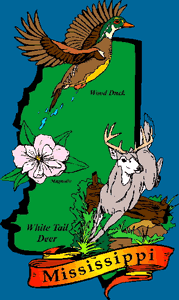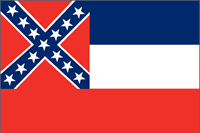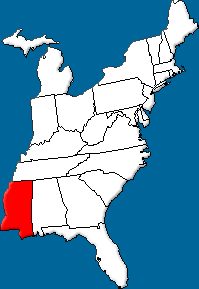


Geography and Landforms:
Mississippi is bordered by Tennessee on the north and the Gulf of Mexico on the south. On the east, Mississippi borders Alabama, and on the west, Arkansas and Louisiana. The highest point in Mississippi is Woodall Mountain, although it can hardly be called a mountain, being only 806 feet above sea level. The major rivers of the state are the Mississippi River, the Big Black River, the Pearl River, and the Yazoo River.
|
 History:
The first European to explore the area that is now Mississippi was Spaniard Hernando De Soto in 1540. De Soto and others were looking for gold. Finding none in the area, they left and did not return. It wasn't until 1682 that a French explorer, Robert Cavelier, Sieur de la Salle clamed the entire Mississippi Valley for his country and named it Louisiana in honor of King Louis XIV.
|
 Economy:
Mississippi has long been one of the most rural states in the US. In the year 2000, Mississippi ranked third in the nation in the production of cotton. Other important crops are rice and soybeans. In addition, industry related to the production of chickens, catfish, and dairying are becoming more important to the state economy.
|
 First Inhabitants:
Before Europeans began to explore the area now known as Mississippi, three major Native American groups lived there. In the north and the eastern parts of the state were the Chickasaw. The Choctaw lived in the central part of territory and the Natchez lived in the southwest.
|
Books Related To MississippiThe Aurora County All-Stars - Deborah Wiles Crossing Bok Chitto: a Choctaw Tale of Friendship & Freedom - Tim Tingle Each Little Bird that Sings - Deborah Wiles Glory Be - Augusta Scattergood How I found the Strong - Margaret McMullan M is for Magnolia: A Mississippi Alphabet - Michael Shoulders Mississippi Trial 1955 - Chris Crowe The Return of Gabriel - John Armistead Roll of Thunder Hear My Cry - Mildred Taylor A Thousand Never Evers - Shana Burg When I Crossed No-Bob - Margaret McMullan Yankee Girl - Mary Ann Rodman |
Famous Citizens:
|
| Capital: | Jackson |
| Entered Union: | December 10, 1817 |
| Population: | 2,994,079 |
| Area | 48,430 |
| Bird | Mockingbird |
| Flower | Magnolia |
| Nickname: | Magnolia State |
| Governor | Phil Bryant |
Places to Visit in Mississippi: (Click the links to learn more.)
|



